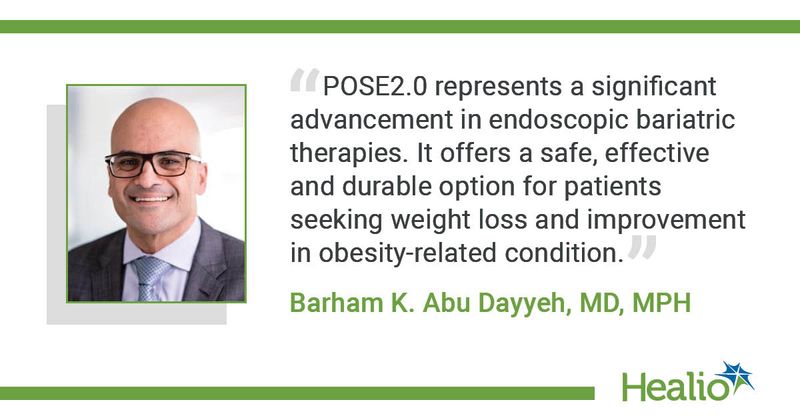‘Durable’ weight loss: Endoscopic gastric remodeling surgery effective in managing obesity
Key takeaways:
- Patients who underwent the Primary Obesity Surgery Endoluminal 2.0 procedure reached 14% total body weight loss at 12 months.
- No serious adverse events related to the device or procedure were reported.
WASHINGTON — The Primary Obesity Surgery Endoluminal 2.0 procedure is a “safe, effective and durable option” for weight loss and improvement in obesity-related conditions, according to a presenter.
“Current treatment options for obesity have limitations in efficacy, cost, durability and invasiveness,” Barham K. Abu Dayyeh, MD, MPH, director of advanced endoscopy and professor of medicine at Mayo Clinic, told Healio. “The POSE2.0 procedure represents a novel approach designed to overcome some of these challenges by creating durable, full-thickness plications in the stomach through an incisionless approach, without removing any parts of the stomach.”

In a study presented at Digestive Disease Week, Abu Dayyeh and colleagues randomly assigned 35 patients with obesity from four academic centers to the Primary Obesity Surgery Endoluminal 2.0 (POSE2.0) procedure with moderate-intensity lifestyle changes (mean age, 43.6 years; 12% men) or to lifestyle changes alone (mean age, 43.2 years; 10% men). Participants were randomized in an open-label, 5:2 fashion.
The primary outcomes were percentage of total body weight loss at 12 months and incidence of adverse events, with secondary outcomes including durability of the plications at 12 months and effect on gastric emptying using the 13C-Spirulina Gastric Emptying Breath Test (Cairn Diagnostics).
According to intention-to-treat analysis, patients in the POSE2.0 group experienced significant total body weight loss at 12 months (12.8% ± 7.55%) compared with the lifestyle changes group (2.5% ± 11.34%; P = .006).
In the per-protocol analysis, the POSE2.0 group reached 14% ± 7.64% total body weight loss at 12 months — “with a majority achieving clinically meaningful weight loss,” Abu Dayyeh said.
Further, no serious adverse events related to the device or procedure were reported.
“Notably, the effects appear durable, with plications remaining fully intact at the 12-month endoscopic evaluation,” he added.
At 2 and 6 months, there was a “mild delay” in gastric emptying of 19.5 minutes ± 42.85 minutes and 19.6 minutes ± 31.68 minutes, respectively; however, this was not associated with weight loss. Additionally, researchers reported no increase in nausea, retching, vomiting or bloating at 1, 2, 6 and 12 months, although there were consistent improvements in fullness at these time points.
“POSE2.0 represents a significant advancement in endoscopic bariatric therapies,” Abu Dayyeh told Healio. “It offers a safe, effective and durable option for patients seeking weight loss and improvement in obesity-related conditions.”
He added, “While these initial results are promising, a larger comparative trial is underway to further validate the efficacy and safety of POSE2.0 compared to other established bariatric interventions. We are also committed to investigating its long-term impact on weight loss and cost-effectiveness compared to other medical and surgical options, and overall health outcomes in diverse patient populations.”

